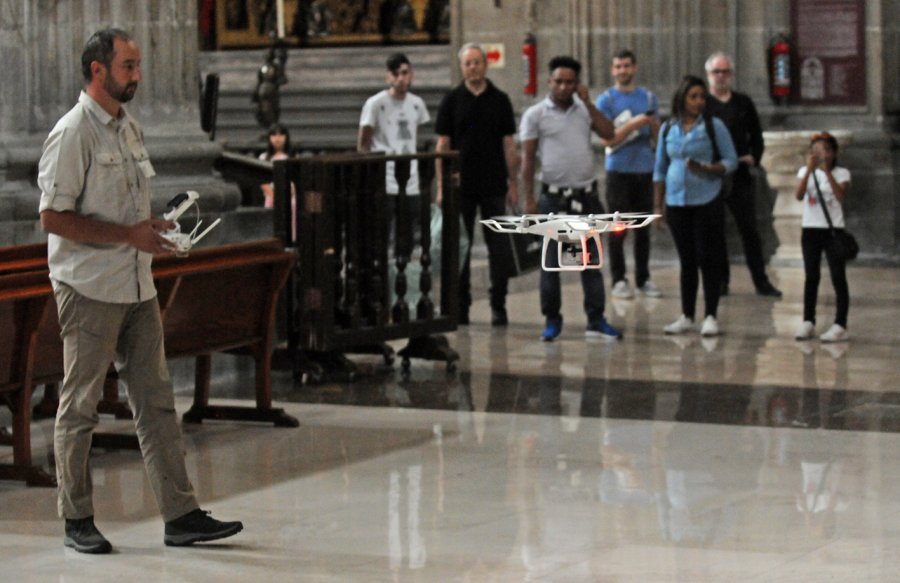Noticias
For the preservation and dissemination of heritage
Digitization and architectural scanning of the Metropolitan Cathedral with the state-of-the-art technology
September 29, 2018The flight of a drone has surprised parishioners and visitors to the Metropolitan Cathedral. Californian specialists are working on the digitalization and scanning of the four buildings that make up the cathedral complex, one of the most important religious sites in our country.
This is the first time that this type of work is carried out in Mexico through drones, high-precision laser scanners and photogrammetry equipment, which will generate high-definition models in three dimensions, which will be very useful for the preservation and dissemination of cultural heritage.
Thanks to the efforts of the Department of Culture, specialists from the Non-Governmental Organization (NGO, for its acronym in Spanish) Cyark, based in San Francisco, California, were able to use these three combined technologies for the first time in the Metropolitan Cathedral, a 6,000 square meters building.
Enrique Varela, coordinator of Professional Reviewers of the General Directorate of Cultural Heritage Sites and Monuments, stressed that "this is the first time that this type of digitalization and scanning work has been done on the Metropolitan Cathedral and the buildings that make up the cathedral complex," because there are four buildings: the Metropolitan Cathedral, the Metropolitan Tabernacle, the Curia and the Chapel of Souls.
These actions with scanners, drones and high definition equipment, "will allow us to have the technical implements necessary to diagnose and have a series of plans that would be difficult to have if it were not for this technology", as well as views that commonly cannot be appreciated, due to the complexity of ascending the 65 meters high towers have”, he said.
The specialist recalled that this cathedral dates from a second construction that began in 1574 and ended 200 years later. It is a very heavy and large building with 60 meters in front and 120 meters long, as well as an estimated weight of 127 thousand tons, which has various architectural styles from the sixteenth to the twentieth century.
Although last year's seismic events did not jeopardize the stability of the cathedral complex, if they generated damages that are currently being attended, however this state-of-the-art technology will allow for major diagnosis from which a second care plan will be implemented.
For his part, Ernesto Miranda, coordinator of the Digital Agenda of the Department of Culture, indicated that these works will not generate any cost for the agency, since Cyark is a non-profit organization that is dedicated to digitizing the cultural heritage worldwide.
With state-of-the-art technology, this NGO generates 3D models that are of great importance for the preservation of cultural heritage, as it allows to make assertive and effective reconstructions after earthquakes and natural disasters.
In addition, the resulting material can be used in other initiatives such as the dissemination of our country's wealth through digital media, to show to the public the relevance of this cultural heritage so they can appropriate it to better protect it.
Finally, Kacey Hadick, Cyark specialist, highlighted that this is the sixth time that this NGO works in Mexico, as it has documented other heritage sites such as the Templo Mayor, Monte Albán, Teotihuacán, Chichen Itzá and Xochicalco.
On this occasion, three specialists from Cyark are in Mexico to carry out the digital documentation of the cathedral complex using three different technologies: drones to capture aerial photos, photo cameras to capture land surfaces and laser scanners to document the geometry of the site.
"For us it's one of the largest buildings we've ever documented, it's bigger than we thought, it takes a long time to complete the documentation," which will generate up to 100 gigabytes of data.
Therefore, he said that the work on the Metropolitan Cathedral took the Cyark team two weeks and will conclude on Saturday September 29 and next week will begin digital documentation of the Palace of Fine Arts, which they plan to do in seven days.
Kacey Hadick also commented that Cyark is a nonprofit organization dedicated to digital documentation and the realization of architectural plans of heritage sites around the world for which it seeks sponsorships from organizations, companies and interested individuals.
Before traveling to Mexico, Cyark's specialists worked on the digitization of a property in France and after being in our country will go to Macedonia to continue their work.
The Mexican authorities recognized the professionalism and attention of Cyark's team and emphasized that all the material generated will be safeguarded by the Department of Culture for its pertinent use.
Mexico
